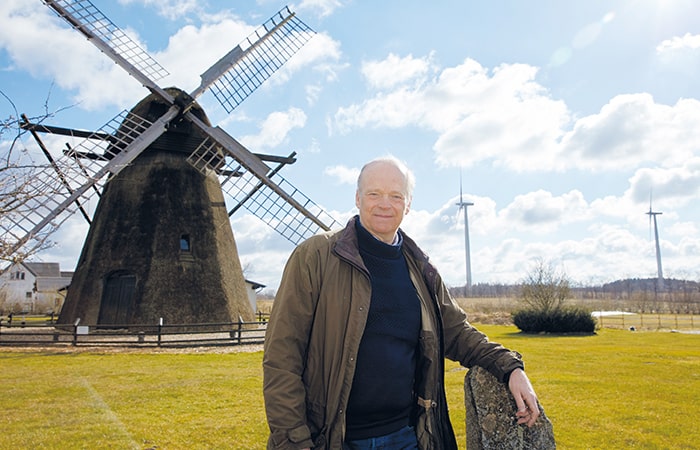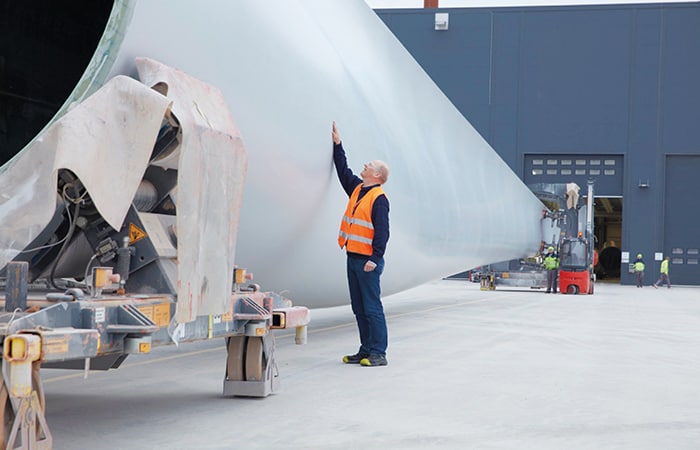
The name of Henrik Stiesdal may be unfamiliar to most readers, but this unassuming elderly Dane may become one of the most significant figures in the history of electricity generation, joining such illustrious names as Nikola Tesla and George Westinghouse. While these earlier giants enabled the industrial-scale generation of electricity that changed the everyday lives of much of the population of the planet, Stiesdal’s innovations may be key to allowing us to maintain these voltage-hungry lifestyles without compromising the planet’s ability to support human life.
Stiesdal is credited with the innovations that enabled the development of the offshore wind turbine, currently the most efficient way to harness the planet’s natural processes to generate electricity without contributing to climate change. With the cost of offshore wind tumbling, and the rapid development of large-scale electricity storage at manageable cost, offshore wind is proving to be the most important type of renewable energy generation around the world. Stiesdal’s achievements saw him shortlisted for the lifetime achievement prize at this year’s European Patent Office Inventor Awards, at a ceremony held in Paris.
During a long career, which has taken him from wind energy pioneers Bonus and Vestas, to Siemens, Stiesdal tackled the main problem preventing wind generation moving from its original home onshore to locations out at sea, where the wind is stronger and more consistent. “The vital parameter is known as capacity factor,” he explained. “That’s the ratio between the actual energy you produce and what you would have produced if the wind conditions allowed you to run your turbine at the full rate all the time. In Denmark nowadays, onshore wind energy has a capacity factor of about 33 per cent. For offshore, you get 50 per cent, so in round figures you get 50 per cent more energy offshore than onshore.”

The problem faced in taking wind turbines out to sea was that the early models, with blades of 25m to 30m long, were just not big enough to take full advantage of the harsher offshore conditions. “These things are big,” Stiesdal said. “We had to work out a way to make them much bigger, and the way we were making them made that difficult. They are composite structures, so to explain it simply, each blade was composed of half-shell, made of fibreglass. That was one side of the blade, with another half-shell that is the other side, and you glued them together with a structure called a shear web on the inside to transfer the shear loads – the forces acting along the width of the blade – from one side to the other. That structure works if the glue joints are good, but many times in the mid-1990s our main supplier did a bad job with the quality of the glue joints and we ended up putting out blades that I was not happy with.
“It was an increasingly stressed situation but to an extent I had to accept it because there was no other supplier capable of doing this work. These people were not evil or bad or stupid, they were doing their best, but this was just a very difficult task.
“We even had to do a lot of testing to make sure that these things wouldn’t come apart and kill people. So I started thinking, ok, what could we do to make the situation better? I always like to look at radical solutions and the radical solution was, if the problem is with the glue joint, just make a blade they didn’t have glue joints. Make it all in one piece.”
This wasn’t easy. The first sticking point was simply the geometry of the blade. “The fundamental issue was that the root of the blade has to be circular so that it can be bolted on to the bearing, but the blade becomes wider as you go out,” he said. “If you are casting in one piece, you have to have an outer mould to form the outer surface and an inner mould and inject your material between the two. And because the root of the blade was narrower than the blade itself, that would mean that the inner mould would not come out. Obviously, you couldn’t send out a blade with the inner mould still in place ... and it wouldn’t work properly if it was not hollow – there’d be no space for the shear web. Nice idea, won’t work.”
Stiesdal went back to the drawing board at his habitual thinking space of the kitchen table, and gradually realised that he was sitting on a potential answer: the cushion of his chair.
“What if we were smart? I thought. What if we had an internal mould that was made of the same sort of open cell foam as the material they used for cushions? It was another radical solution – make a blade without glue joints: you can’t do that because you can’t get the inner mould out: make an inner mould that you can get out. If you put the open cell foam inner mould inside a vacuum bag, when you’ve injected the material and cast your blade you can pump all the air out of the foam, collapse the inner mould inside its bag and just pull it out through the root of the blade. I make it sound like it was all my idea, but of course it came out of idea ping-pong with colleagues and it was executed for the first time on one of our kitchen tables, of course.
“We tested it with 30m blades and moved up, and the last time I visited the factory they were doing serial production with 75m blades. That is big, it’s 25 tonnes of fibreglass, injected one piece. If you turn the blade so the trailing edge is upwards, it will sit on the floor and there’s enough space inside for the trajectory of an ideal basketball penalty throw.”
Stiesdal doesn’t underplay how difficult the project was. “I have to say it was fun but not easy. Whenever you do radical things like that you also expect the problems to be radical, but they were not, they were mundane, but they were many. Common issues, all kinds of small things. But now this is how we make these blades, we’ve done many thousands, even tens of thousands, and has been fantastic for me to see the kitchen table thing transformed into a big industry.”
There may be many applications for this form of single-piece casting, but Stiesdal explained that Siemens chose not to investigate and exploit them.
“Every time I’ve been asked I realise you need to know your limitations, you need to know the cost of de-focusing,” he said. “We need to be humble about what we can master, so let’s focus on this. We could give out a licence, of course, to somebody, but at the end of the day it would require some effort from us in serving such a licensee with the know-how. Would it actually matter, in the big picture, to have an income from that when it would take away some of our ability to focus?”
Although Stiesdal has now retired, he is still thinking about offshore wind power (to his wife’s frequent frustration, he notes). What is currently exercising him is that offshore wind farms are still difficult to build. Although in the UK and Scandinavia, we are used to being able to site tall offshore turbines in the North Sea, this sort of shallow-water environment near major population centres is actually very rare around the world.
“In California, Japan, Korea, Brazil and India, it’s much more common to have very deep water near population centres. And that means you have to go to floating turbines,” Stiesdal said. “They exist, of course, but they are still expensive and that’s because the technology for floating foundations comes from shipbuilding and offshore oil and gas, and those industries are not set up for very high volume production so they tend to be higher cost. We need to be able to reduce the cost of these offshore foundations.”
Stiesdal has come up with a typically radical solution. Rather than think of what he wants to make and find a production process to make it, with the inevitable consequence of having to assemble a supply chain and drive down costs from prototyping, he thinks a better solution would be to look for manufacturing processes that are keyed to producing low-cost products and devise something that can be made using these processes.
“The cheapest steel item you can buy these days is an offshore wind turbine tower. They are dirt cheap, they use welding machines where the quality is easy to control and the cost per kilo is very low for a strong, high-quality product,” he said. “My idea is to place a tower on top of a structure made of components no bigger than the tower, so the whole thing can be made in a factory and taken to the port where it can be assembled to be taken out to sea. The answer is to make the structure a tetrahedron; they are very strong and relatively easy to assemble. That means you haven’t got to use production facilities whose only advantage is that they are near a port; you can use the most competitive and transport components to where they need to be.”
The product is undergoing offshore testing, and has the potential to bring the cheap benefits of offshore wind to a much larger proportion of the world’s population.




IEA report claims batteries are ‘changing the game’
The weight and bulk of static batteries, even domestic units, is immaterial. The IEA's trilemma is illustrated here:-...